Mechanical Performance of Recycled Reinforced Polyamide from Rejected Railway Fastenings Flanged Plates
Abstract
1. Introduction
2. Material and Methods
2.1. Material
2.2. Viscosity
2.3. Mechanical Tests
2.4. Fractography
2.5. Micro-Computed Tomography
2.6. Analysis of Data and Statistics
3. Results
3.1. Viscosity
3.2. Tensile Tests
3.3. Charpy Impact Tests
3.4. LOCATI Fatigue Test
3.5. Fracture Toughness Test
3.6. Fractographic Analysis
3.7. Micro-CT Analysis
3.8. Fiber Length Analysis
4. Discussion
5. Conclusions
- The decrease in viscosity is a consequence of the shortening of the polymeric chains caused by the successive injections and is concentrated before the fifth recycling. Having studied the effect on the properties of up to 10 recyclings and considering the restrictive values of the ADIF Technical Specification, up to a third recycling would be admissible.
- The mechanical properties are all detrimentally affected by the process of recycling. The mechanical behavior of the reinforce polyamide is strongly dependent on the shortening of the glass fibers and the length distribution of the fibers as well as on the specific conditions at the interface between the fibers and matrix. The effect of up to three recyclings (R3) has been found to be a 30% reduction in the original average fiber length.
- The porosity of the material, due to the incorporation of polyamide powder produced in the grinding, continuously increases with the number of recyclings acting as preferential paths for the propagation of the cracks.
- SEM analysis evidences the existence of two different types of fracture micromechanisms after the LOCATI fatigue test: namely, the thermal failure and the mechanical failure.
- From the economic point of view, the recovery of this material would imply an important saving of 37% in costs per kilometer.
- From the environmental point of view, recycling the plates by mechanical crushing reduces pollutions such as air emissions of polymeric dust and volatile organic compounds (caprolactam and thermal oil), wastewater discharges with organic (cyclopentanone and hexamethylenediamine) and inorganic (mainly ammonia) content as well as solid waste.
Author Contributions
Funding
Institutional Review Board Statement
Informed Consent Statement
Data Availability Statement
Conflicts of Interest
References
- Plastics—The Facts 2019. An Analysis of European Latest Plastics Production, Demand and Waste Data; PlasticsEurope: Brussels, Belgium, 2020.
- Zaghloul, M.M.Y.M. Mechanical properties of linear low-density polyethylene fire-retarded with melamine polyphosphate. J. Appl. Polym. Sci. 2018, 135, 46770. [Google Scholar] [CrossRef]
- Zaghloul, M.M.Y. Experimental and modeling analysis of mechanical-electrical behaviors of polypropylene composites filled with graphite and MWCNT fillers. Polym. Test. 2017, 63, 467–474. [Google Scholar] [CrossRef]
- Zaghloul, M.M.Y.; Mohamed, Y.S.; El-Gamal, H. Fatigue and tensile behaviors of fiber-reinforced thermosetting composites embedded with nanoparticles. J. Compos. Mater. 2018, 53, 709–718. [Google Scholar] [CrossRef]
- Zaghloul, M.M.Y.; Zaghloul, M.M.Y. Influence of flame retardant magnesium hydroxide on the mechanical properties of high density polyethylene composites. J. Reinf. Plast. Compos. 2017, 36, 1802–1816. [Google Scholar] [CrossRef]
- Olabisi, O.; Adewale, K. (Eds.) Handbook of Thermoplastics, 2nd ed.; CRC Press: Boca Raton, FL, USA, 2015; ISBN 0824797973. [Google Scholar] [CrossRef]
- Ehring, R.J. (Ed.) Plastic Recycling: Products and Processes; Hanser Publishers: Munich, Germany, 1992. [Google Scholar] [CrossRef]
- La mantia, F. (Ed.) Handbook of Plastics Recycling; Rapra Technology: Shrewsbury, UK, 2002; ISBN 1-85957-325-8. [Google Scholar]
- ISO 527-4:1997; Plastics—Determination of Tensile Properties—Part 4: Test Conditions for Isotropic and Orthotropic Fibre-Reinforced Plastic Composites. International Organization for Standardization: Geneva, Switzerland, 1997; p. 11.
- ISO 179-2:1997; Plastics—Determination of Charpy Impact Properties—Part 2: Instrumented Impact Test. International Organization for Standardization: Geneva, Switzerland, 1997; p. 17.
- ASTM D5045-14; Standard Test Methods for Plane-Strain Fracture Toughness and Strain Energy Release Rate of Plastic Materials. In Book of Standards Volume: 08.02; ASTM International: West Conshohocken, PA, USA, 2014.
- ISO 294-1:2017; Plastics—Injection Moulding of Test Specimens of Thermoplastic Materials—Part 1: General Principles, and Moulding of Multipurpose and Bar Test Specimens. International Organization for Standardization: Geneva, Switzerland, 2017.
- ISO 1874-2:2012; Plastics—Polyamide (PA) Moulding and Extrusion Materials—Part 2: Preparation of Test Specimens and Determination of Properties. International Organization for Standardization: Geneva, Switzerland, 2002.
- Moulding Manual for DuPont MINLON and ZYTEL Resins. Available online: https://www.distrupol.com/Zytel_and_Minlon_Nylon_Resin_Molding_Guide_GNE-A11218-00-A1216_050117_OM.PDFF (accessed on 6 November 2022).
- Akulon S223-HG7; Recommendations for Injection Molding. Akulon: Heerlen, The Netherlands.
- Eriksson, P.; Albertsson, A.; Boydell, P.; Eriksson, K.; Månson, J. Reprocessing of fiberglass reinforced polyamide 66: Influence on short term properties. Polym. Compos. 1996, 17, 823–829. [Google Scholar] [CrossRef]
- Pedroso, A.; Mei, L.; Agnelli, J.; Rosa, D. Properties that characterize the propagation of cracks of recycled glass fiber reinforced polyamide 6. Polym. Test. 1999, 18, 211–215. [Google Scholar] [CrossRef]
- Eriksson, P.; Boydell, P.; Eriksson, K.; Mánson, J.; Albertsson, A. Effect of thermal-oxidative aging on mechanical, chemical, and thermal properties of recycled polyamide 66. J. Appl. Polym. Sci. 1997, 65, 1619–1630. [Google Scholar] [CrossRef]
- ISO 307:2007; Plastics—Polyamides—Determination of Viscosity Number. International Organization for Standardization: Geneva, Switzerland, 2007; p. 33.
- Locati, L. La Fatica Dei Materiali Metallici; Hoepli: Milano, Italy, 1950. [Google Scholar]
- Locati, L. Programmed fatigue test, variable amplitude rotat. Metall. Ital. 1952, 44, 135–144. [Google Scholar]
- Casado, J. Comportamiento en Fatiga de Poliamidas Reforzadas con Fibra de Vidrio Corta; University of Cantabria: Santander, Spain, 2001. [Google Scholar]
- Maspoch, M.; Ferrando, H.; Velasco, J. Characterisation of filled and recycled PA6. Macromol. Symp. 2003, 194, 295–303. [Google Scholar] [CrossRef]
- Crespo, J.E.; Parres, F.; Peydro, M.A.; Navarro, R. Study of Rheological, Thermal, and Mechanical Behavior of Reprocessed Polyamide 6. Polym. Eng. Sci. 2013, 53, 679–988. [Google Scholar] [CrossRef]
- Su, K.H.; Lin, J.H.; Lin, C.C. Influence of reprocessing on the mechanical properties and structure of polyamide 6. J. Mater. Process. Technol. 2007, 192–193, 532–538. [Google Scholar] [CrossRef]
- Casado, J.A.; Carrascal, I.; Diego, S.; Polanco, J.A.; Gutiérrez-Solana, F.; García, A. Mechanical behavior of recycled reinforced polyamide railway fasteners. Polym. Compos. 2010, 31, 1142–1149. [Google Scholar] [CrossRef]
- Diego, S. Estudio de Viabilidad de Reutilización de Poliamida Reforzada con Fibra de Vidrio Corta Para Inyectar Placas de sujeción de vía de Ferrocarril Para alta Velocidad Española (AVE); University of Cantabria: Santander, Spain, 2014. [Google Scholar]
- ADIF Administrador de Infraestructuras Ferroviarias. Placas Acodadas Ligeras de Sujeción—ET 03.360.578.3; Renfe. UN Mantenimiento de Infraestructura; Dirección Técnica; ADIF Administrador de Infraestructuras Ferroviarias: Madrid, Spain, 2001. [Google Scholar]
- Integrated Pollution Prevention and Control Reference Document on Best Available Techniques in the Production of Polymers. 2007. Available online: https://eippcb.jrc.ec.europa.eu/sites/default/files/2020-03/superseded_lvoC_bref_0203.pdf (accessed on 13 September 2022).

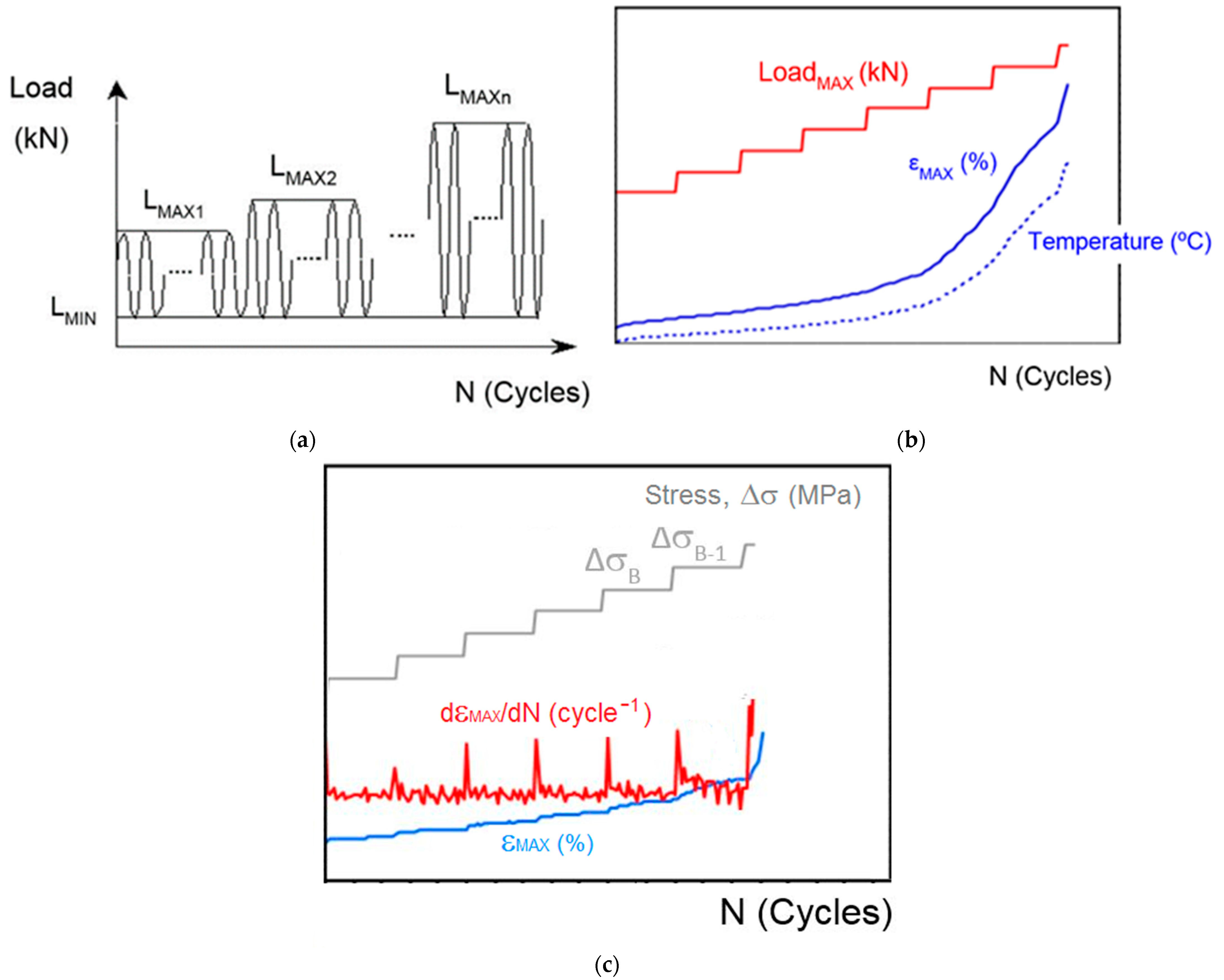
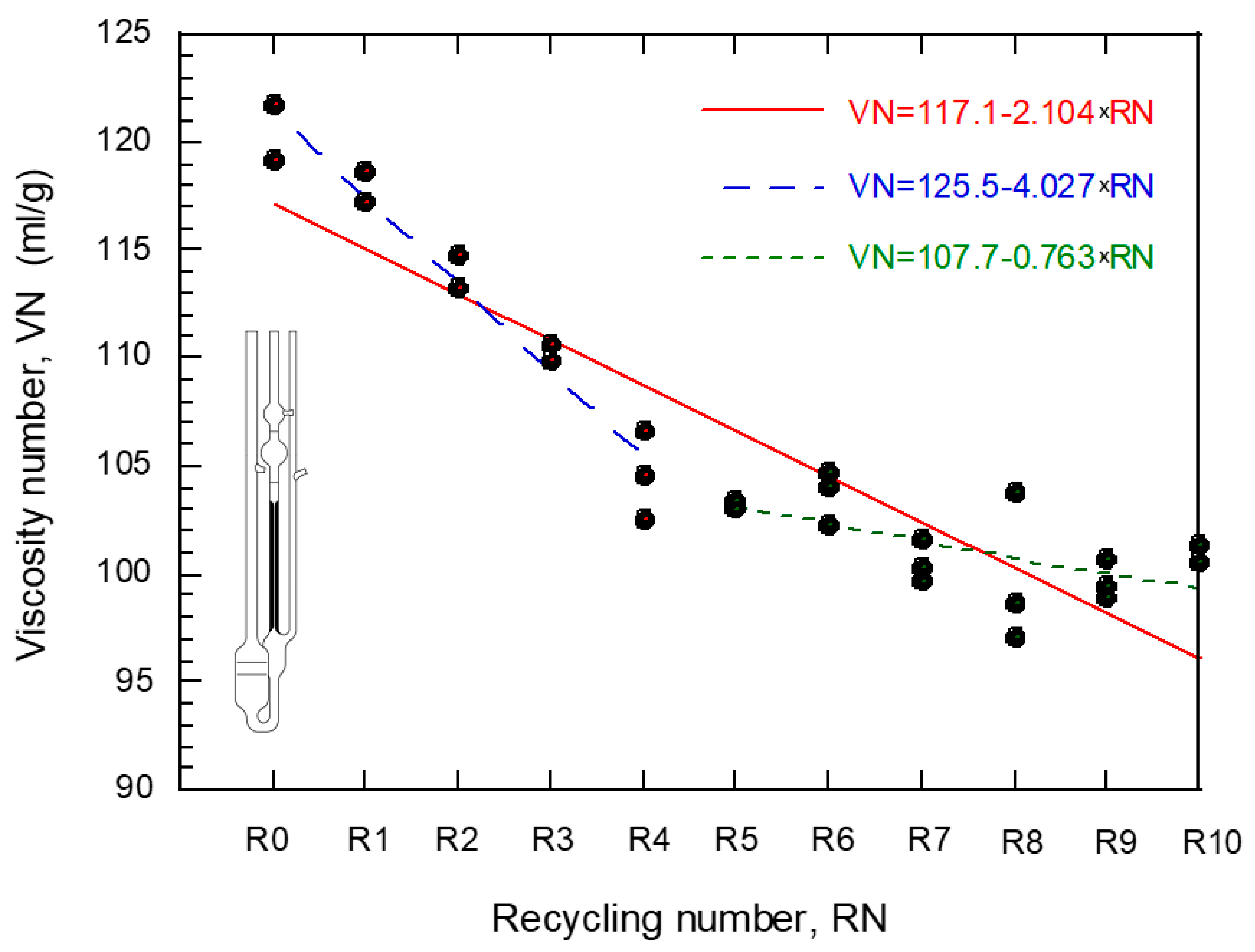

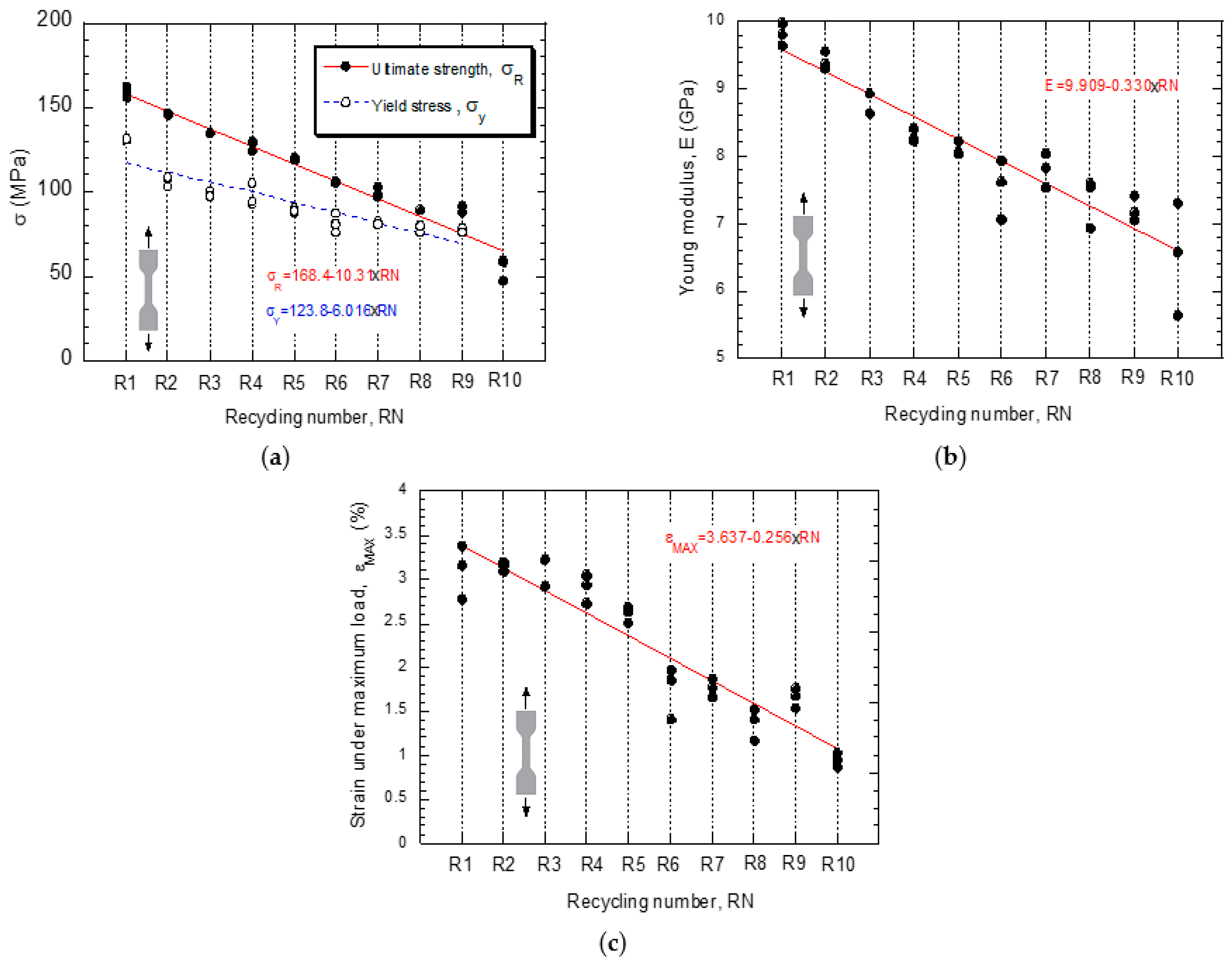


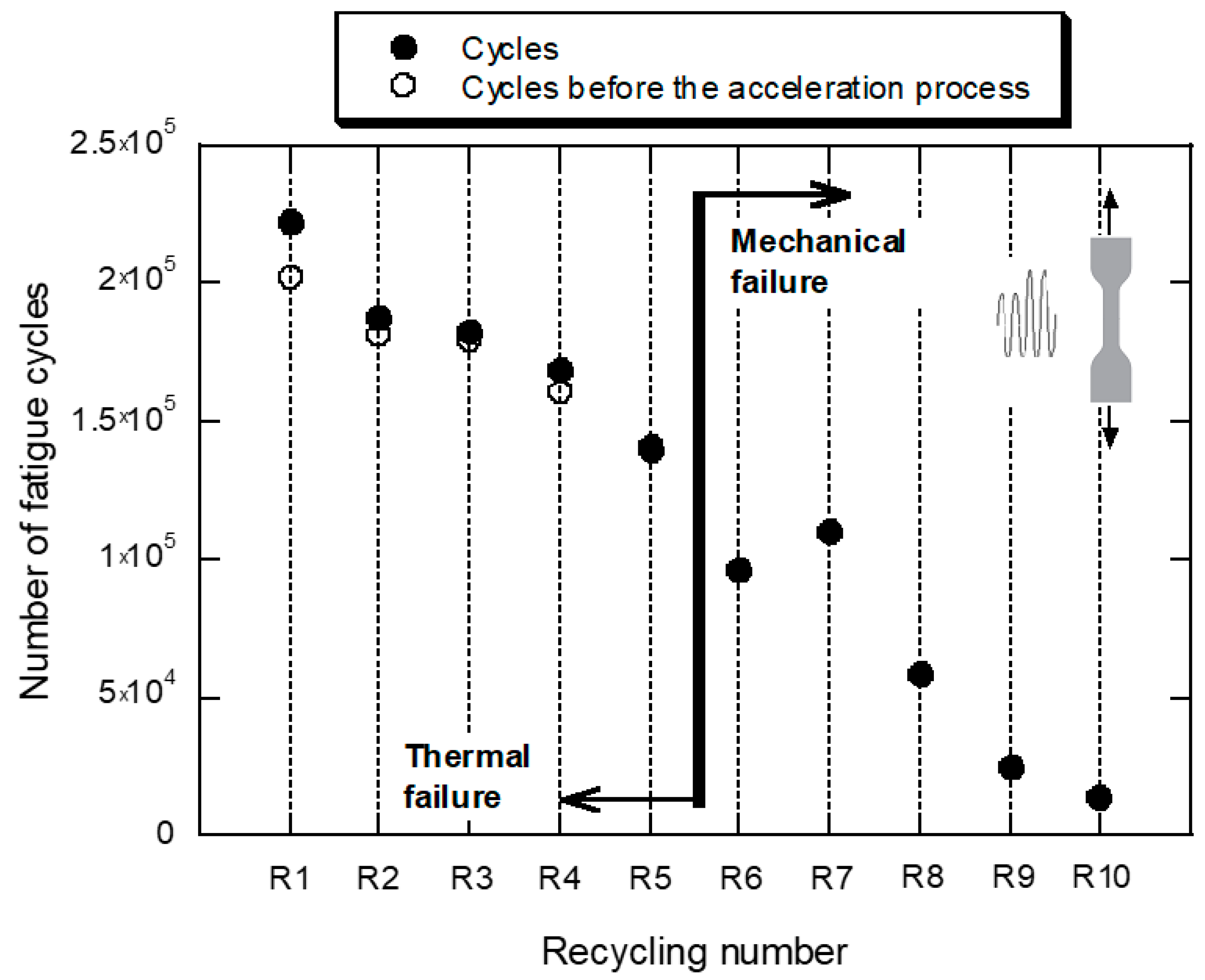
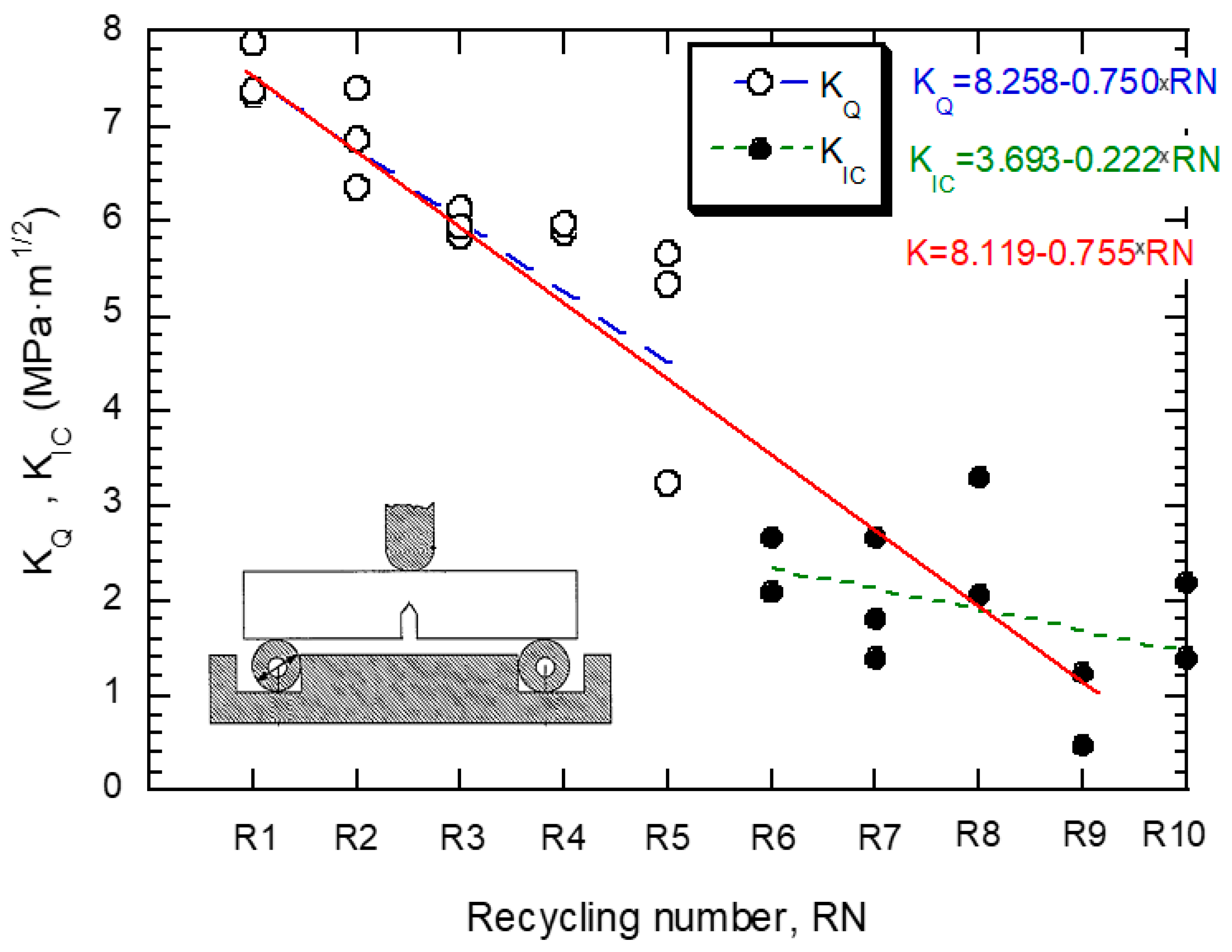
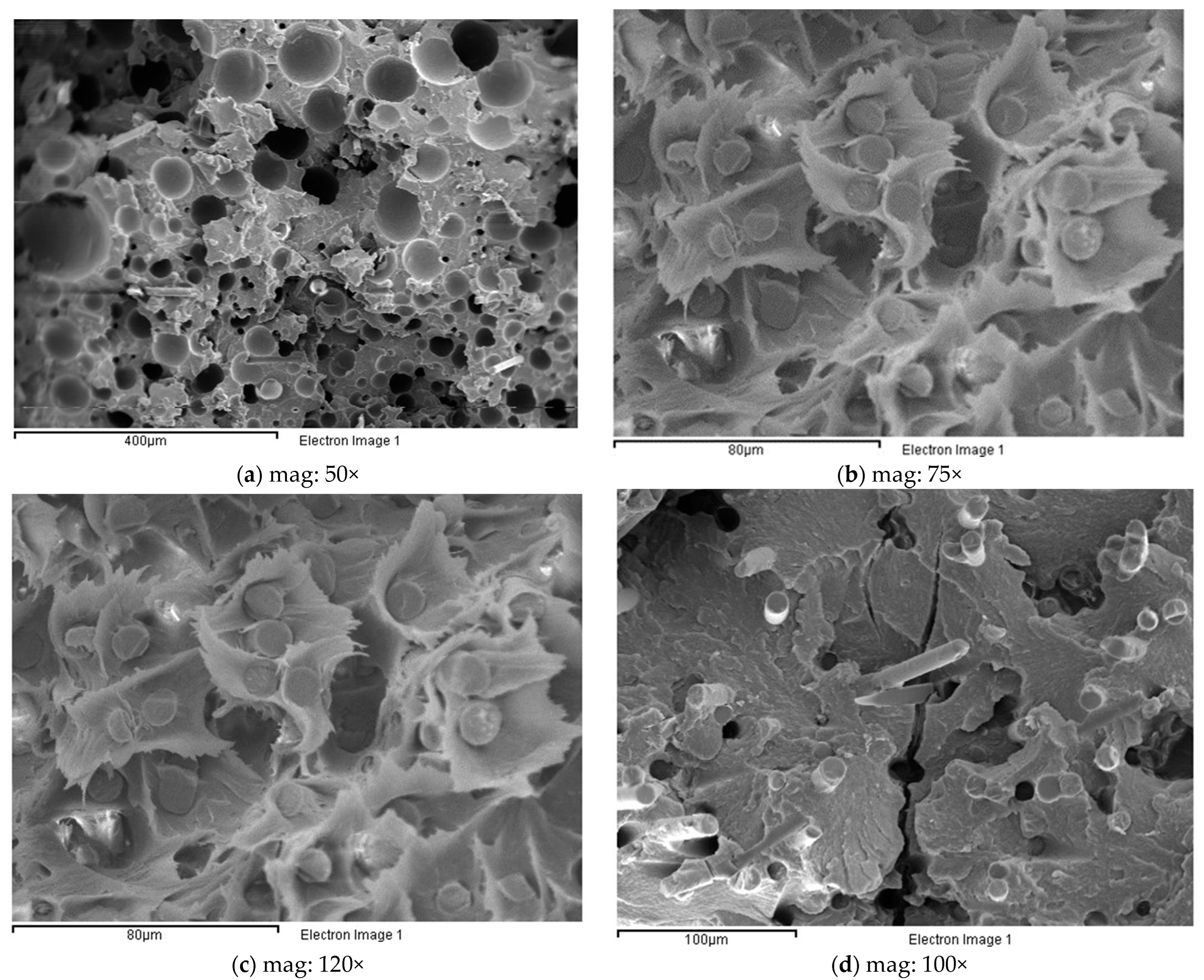
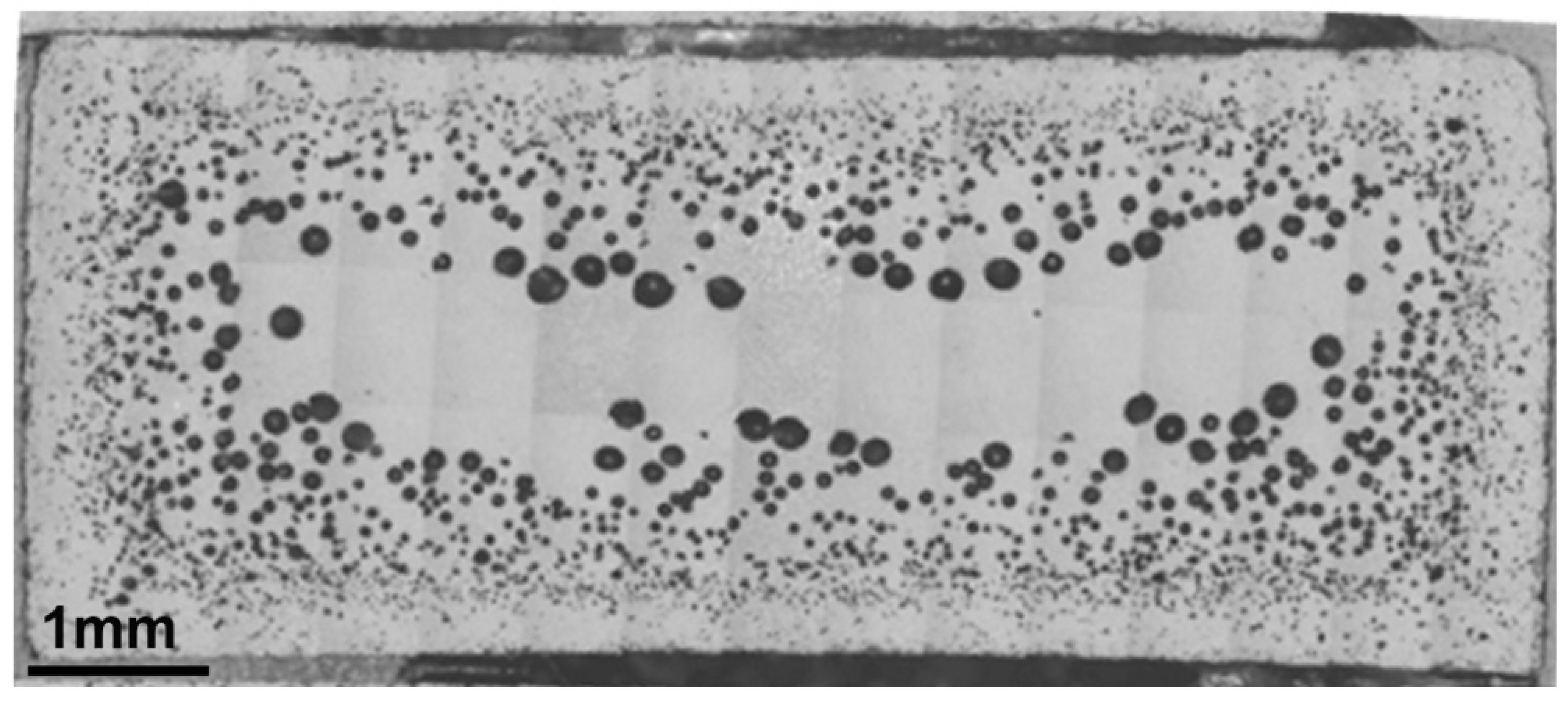
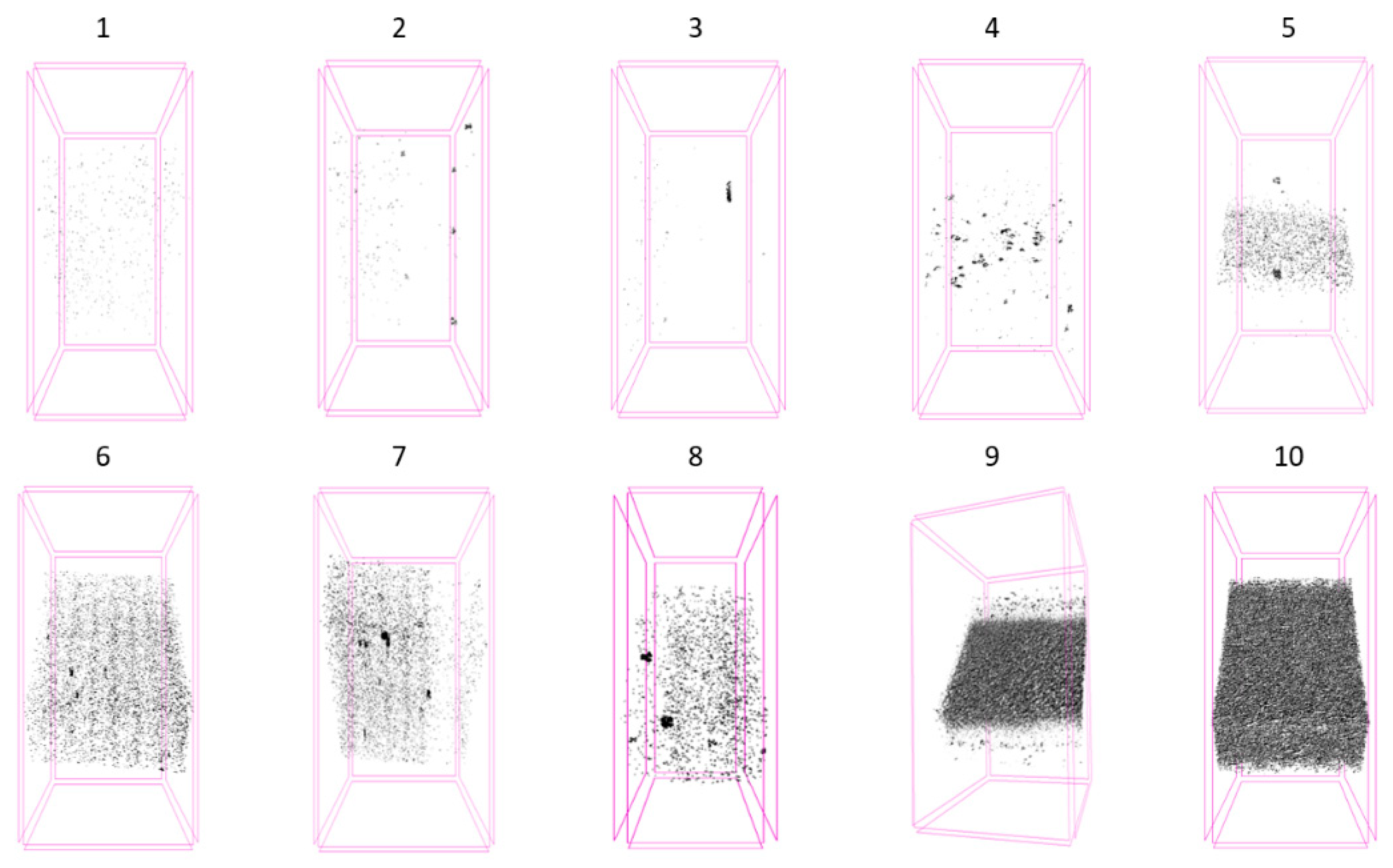
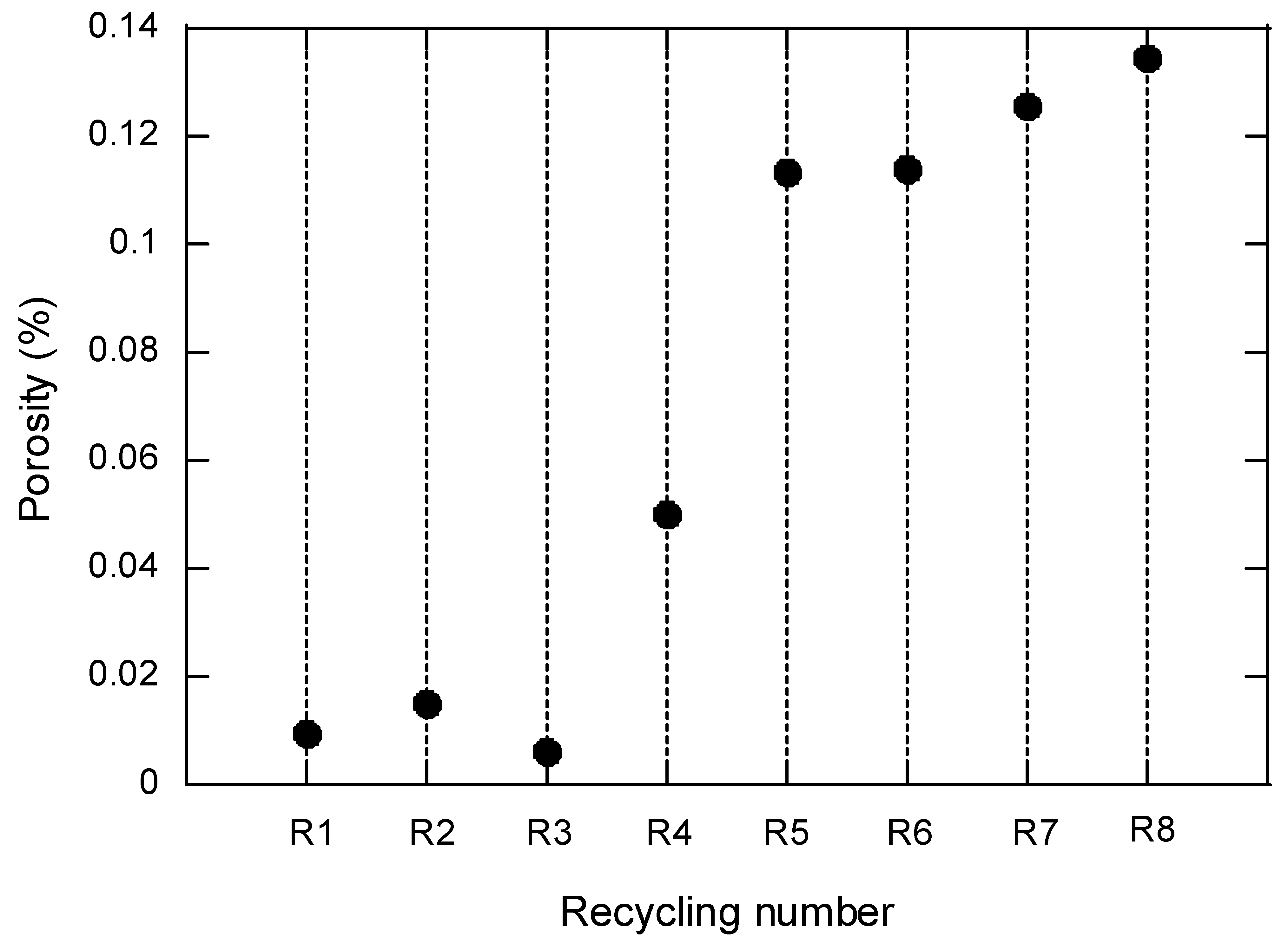
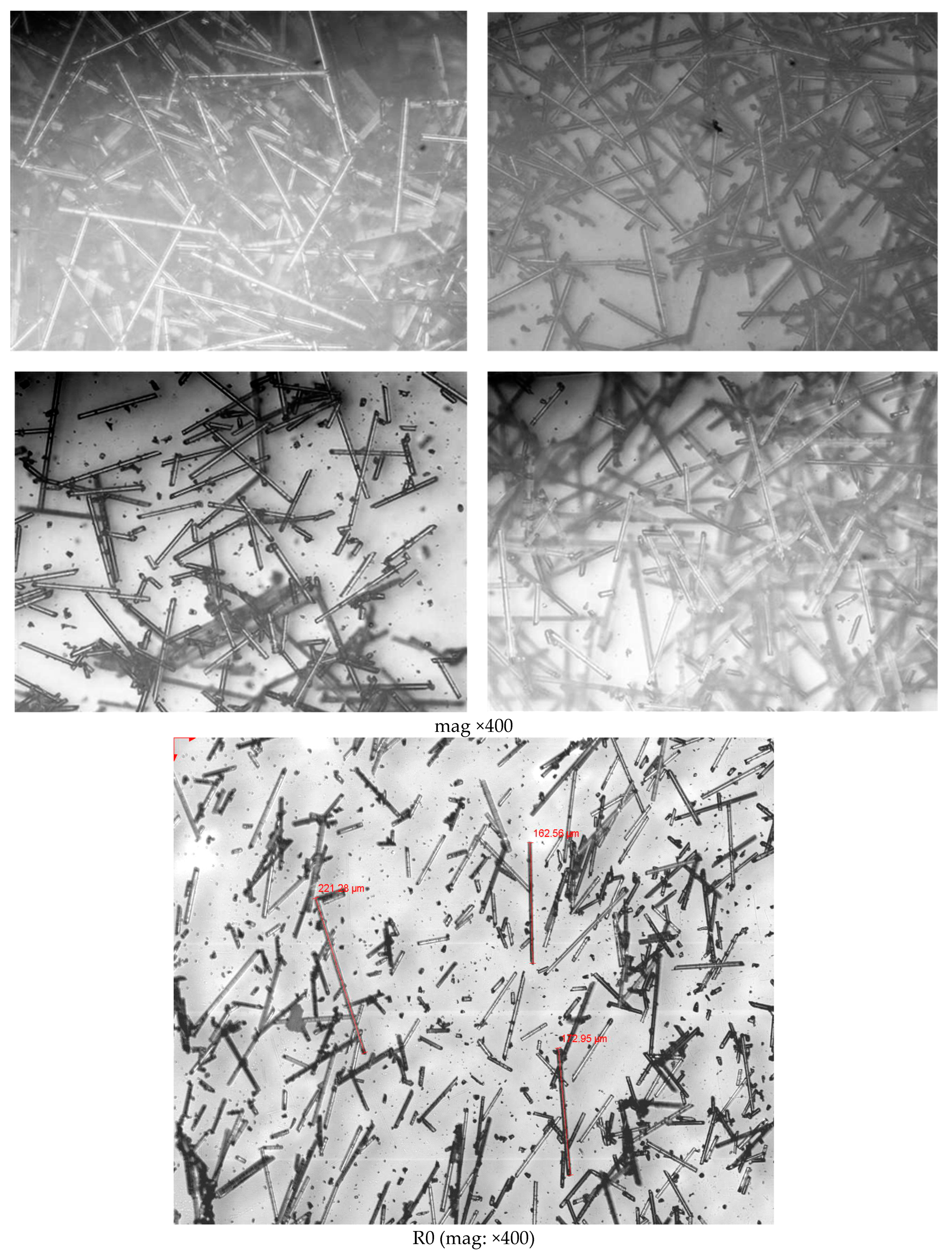

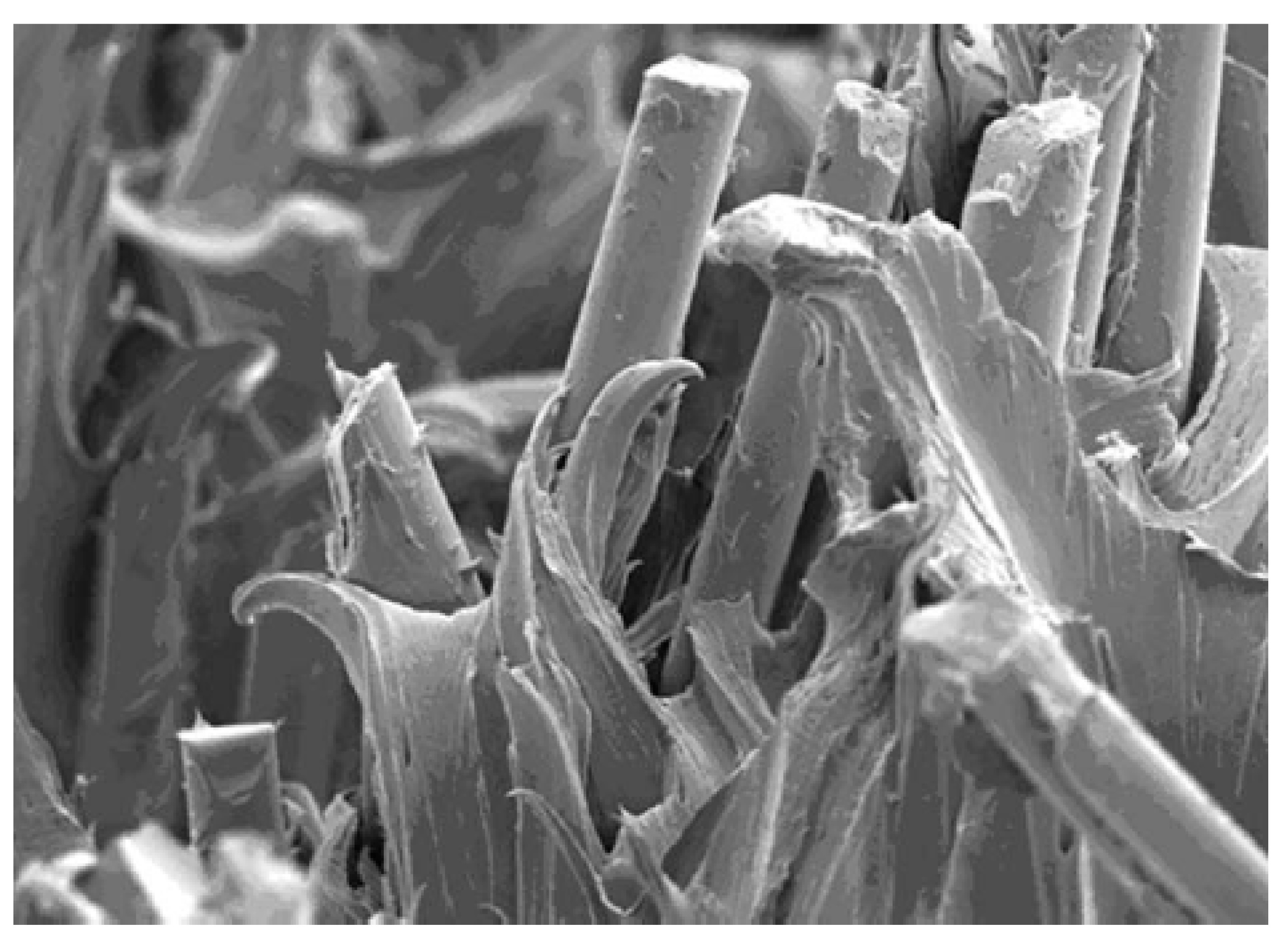
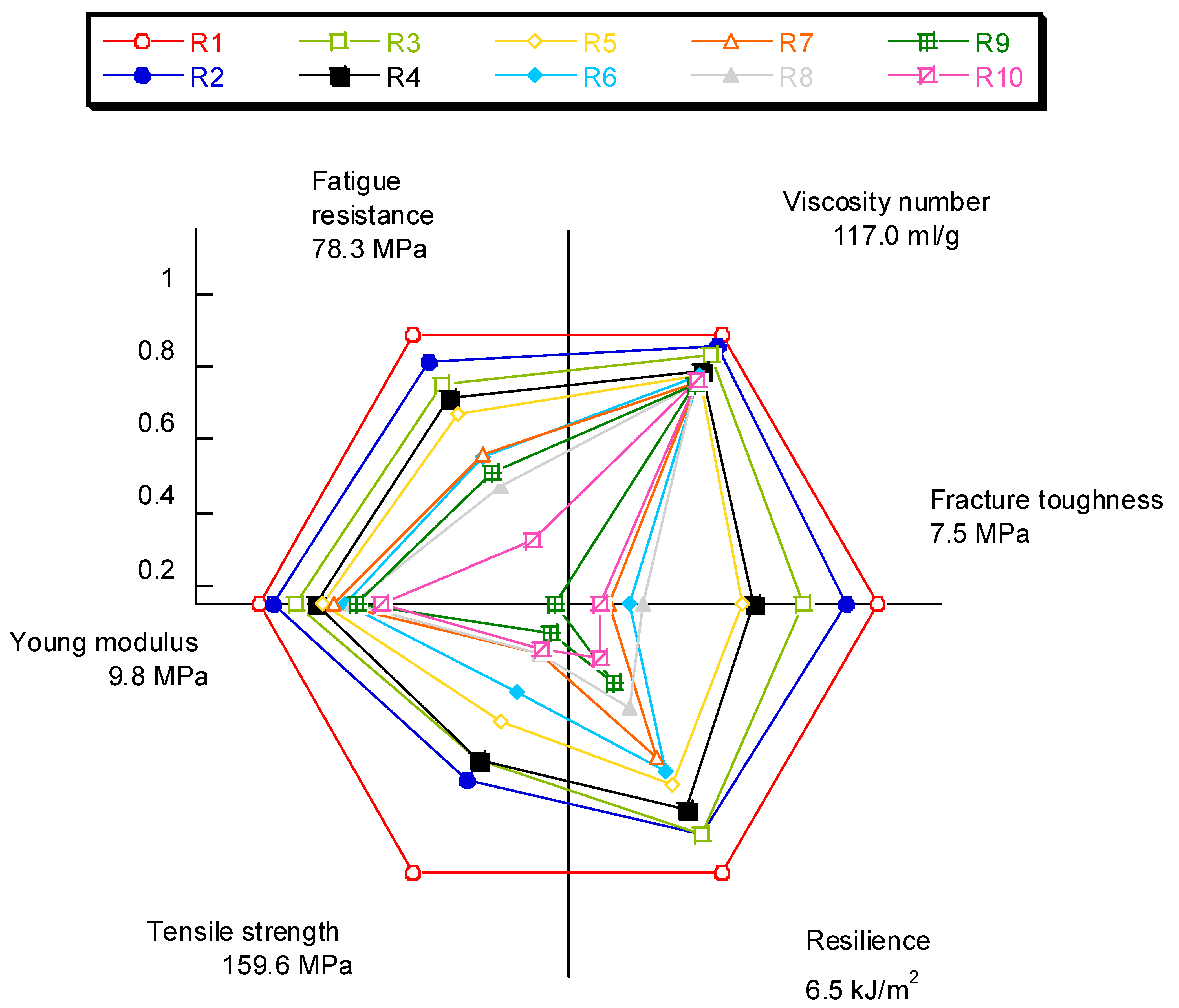
| Chemical Composition | (Weight %) | Properties | Units | Value |
|---|---|---|---|---|
| SiO2 | 52.4 | Tensile stress (σf) | GPa | 3.45 |
| Al2O3. Fe2O3 | 14.4 | Modulus of elasticity (Ef) | GPa | 72.50 |
| CaO | 17.2 | Deformation at break (εf) | % | 3.30–4.48 |
| MgO | 4.6 | Density (ρf) | g/cm3 | 2.60 |
| Na2O. K2O | 0.8 | σf/ρf | (GPa·cm3)/g | 1.30 |
| Ba2O3 | 10.6 | Ef/ρf | (GPa·cm3)/g | 28.00 |
| Fiber diameter (d) | μm | 3–25 | ||
| Coeff. linear thermal expansion | 10−6/K | 5.00 |
| Properties DAM Condition | Standard (ISO) | Units | DUPONT | BASF | DSM |
|---|---|---|---|---|---|
| Tensile strength | 527-2 | MPa | 210 | 210 | 200 |
| Young’s modulus | 527-2 | GPa | 11.2 | 11.5 | 11 |
| Elongation at break | 527-2 | % | 3.2 | 3 | 3 |
| Creep modulus 1 h | 899-1 | GPa | 8.4 | - | - |
| Resist. impact Charpy with notch (−30/23 °C) | 179/1eA | kJ/m2 | 10/15 | 12/14 | 11/13 |
| Rockwell hardness (M/R) | 2039-2 | - | 105/125 | - | - |
| Melting temperature | 11357-3 | °C | 262 | 260 | 260 |
| Glass transition temperature | 11357-2 | °C | 80 | - | - |
| Bending temperature (1.8 MPa) | 75-1/2 | °C | 250 | 250 | 250 |
| Specific heat | - | J/(kg·K) | 2300 | - | |
| Surface resistivity | IEC60093 | Ω·m | >1.0 × 1015 | - | - |
| Dissipation facto 1 MHz | IEC60250 | – | 0.014 | 0.020 | 0.014 |
| Density | 1183 | g/cm3 | 1.41 | 1.41 | 1.41 |
| Viscosity no. | 307 | cm3/g | 130 | 145 | 155 |
| Water absorption sat. | 62 | % | 5.5 | 5 | 5.5 |
| Parameter | Value |
|---|---|
| Mold temperature | Room temperature |
| Barrel temperature | 300 °C |
| Melt temperature | 300 °C |
| Cooling time | 30 s |
| Total cycle time | 50 s |
| Screw speed | 29 m/min |
| Injection speed | 18/25 (cm3/s) |
| Injection pressure | 1800 bar |
| Back pressure | 50/400/500 bar |
| Data | β0 | β1 | R2 |
|---|---|---|---|
| R0–R10 | 117.1 (114.7, 119.6) | −2.104 (−2.501, −1.708) | 0.8269 |
| R0–R4 | 125.5 (123.6, 127.3) | −4.027 (−4.741, −3.314) | 0.9476 |
| R5–R10 | 107 (102.1, 111.8) | −0.763 (−1.397, −0.129) | 0.3224 |
| Property | β0 | β1 | R2 |
|---|---|---|---|
| E (MPa) | 9.909 (9.594, 10.22) | −0.3301 (−0.3801, −0.28) | 0.8715 |
| σY (MPa) | 123.8 (117.2, 130.3) | −6.016 (−7.191, −4.841) | 0.8299 |
| σR (MPa) | 168.4 (161.4, 175.4) | −10.31 (−11.42, −9.192) | 0.9302 |
| εMAX | 3.637 (3.397, 3.877) | −0.2561 (−0.2942 −0.2179) | 0.8755 |
| Group | β0 | β1 | R2 |
|---|---|---|---|
| R0–R10 | 6.112 (5.613, 6.611) | −0.5000 (−0.5803, −0.4204) | 0.8529 |
| R0–R7 | 6.372 (6.032, 7.212) | −0.6511 (−0.7828, −0.5193) | 0.8492 |
| R8–R10 | 2.385 (−0.2234, 4.883) | −0.055 (−0.3375, 0.2275) | 0.02938 |
| Group | β0 | β1 | R2 |
|---|---|---|---|
| R1–R10 | 8.119 (7.308, 8.93) | −0.7551 (−0.895, −0.6152) | 0.8380 |
| R1–R5 | 8.258 (7.088, 9.428) | −0.7504 (−1.103, −0.3977) | 0.619 |
| R6–R10 | 3.693 (0.6452, 6.741) | −0.222 (−0.6016, 0.1577) | 0.1628 |
Publisher’s Note: MDPI stays neutral with regard to jurisdictional claims in published maps and institutional affiliations. |
© 2022 by the authors. Licensee MDPI, Basel, Switzerland. This article is an open access article distributed under the terms and conditions of the Creative Commons Attribution (CC BY) license (https://creativecommons.org/licenses/by/4.0/).
Share and Cite
Diego, S.; Casado, J.; Carrascal, I.; Sainz-Aja, J.; Ferreño, D. Mechanical Performance of Recycled Reinforced Polyamide from Rejected Railway Fastenings Flanged Plates. Polymers 2022, 14, 4940. https://doi.org/10.3390/polym14224940
Diego S, Casado J, Carrascal I, Sainz-Aja J, Ferreño D. Mechanical Performance of Recycled Reinforced Polyamide from Rejected Railway Fastenings Flanged Plates. Polymers. 2022; 14(22):4940. https://doi.org/10.3390/polym14224940
Chicago/Turabian StyleDiego, Soraya, Jose Casado, Isidro Carrascal, Jose Sainz-Aja, and Diego Ferreño. 2022. "Mechanical Performance of Recycled Reinforced Polyamide from Rejected Railway Fastenings Flanged Plates" Polymers 14, no. 22: 4940. https://doi.org/10.3390/polym14224940
APA StyleDiego, S., Casado, J., Carrascal, I., Sainz-Aja, J., & Ferreño, D. (2022). Mechanical Performance of Recycled Reinforced Polyamide from Rejected Railway Fastenings Flanged Plates. Polymers, 14(22), 4940. https://doi.org/10.3390/polym14224940







